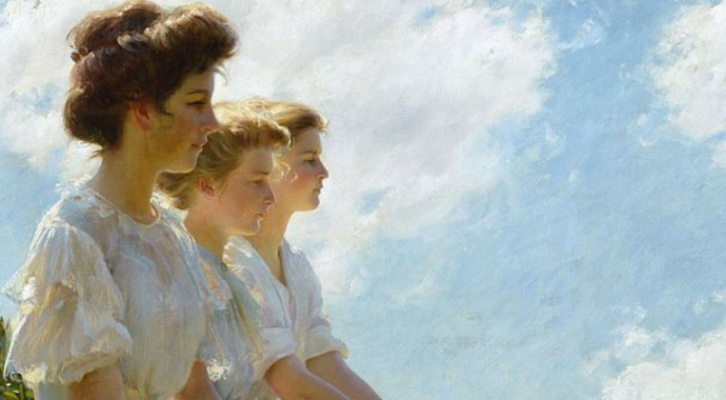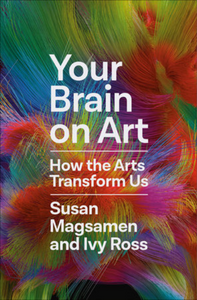
Hitting the Aesthetic Triad While Gazing at Art
Susan Magsamen and Ivy Ross on the Workings of Neuroaesthetics
What’s happening in your brain and body when you are having an aesthetic experience?
This is a question that has occupied Anjan Chatterjee for many years. Anjan is a professor of neurology, psychology, and architecture at the University of Pennsylvania, where he founded one of the world’s first labs dedicated to neuroscience and aesthetics, the Penn Center for Neuroaesthetics.
Around 2014, Anjan and colleagues developed a theoretical model known as the aesthetic triad, and it explains how three components—our sensorimotor systems, our reward system, and our cognitive knowledge and meaning-making—combine to form an aesthetic moment.
The model is a Venn diagram depicting three interconnecting circles to illustrate the dynamic nature of your individual aesthetic-making process.
When you gaze at artwork your body and brain, through your sensorimotor systems, bring in information. This is the first circle of the aesthetic triad.
The second circle is your brain’s reward system. This is a set of neural structures, or circuits, that activate when you experience happiness or pleasure. When the reward system comes online, it increases the probability that you repeat the behaviors that occurred prior to the event that sparked it. Typically behaviors that activate the reward system are ones that help the brain to keep us alive—eating, drinking, and sleeping—or ones that help the brain to keep our species alive, such as reproductive behaviors.
It’s here that you register love, and the pleasures of a fantastic meal, for example. As Anjan explained to us, “When we’re talking about pleasure preferences we are activating our general reward system which is also used for very basic things like food and sex. The pleasure that we get out of art—when we think the art is beautiful—offers the same basic response.”
It’s in the third circle of meaning-making where aesthetic experiences are highly contextual. Your culture, your personal history, and the time and place in which you live all inform how you perceive and respond to something.
At the center of these three nodes lies an experience that registers as aesthetic for you. That experience consists of a combination of factors unique to you and your biology and circumstances as well as containing some universal qualities that all humans find aesthetically compelling.
Often, beauty and aesthetic experiences are confused as the same thing, and so we asked Anjan to help define beauty for us. Which is a lot like trying to define the nature of love. But Anjan was up for the challenge. He began by breaking beauty, and our perceptions of it, into three overarching areas: people, places, and things.
Where we come from, how we were raised, and our unique experiences all contribute to what we perceive as beautiful.
When it comes to people and places, there are certain elements that we tend to weigh similarly. For instance, studies have shown that most people around the world perceive a beautiful face similarly. When presented with a variety of faces, we home in on similar attributes, such as symmetry and perceived kindness, as contributing to facial beauty. It’s a swift and automatic response.
The same holds true for landscapes, where people tend to find certain elements—like sunsets on the horizon of the ocean—to be pleasing. In both cases, studies by Anjan and others have shown that our ventral medial prefrontal cortex comes online when we determine that a face or a place is beautiful.
With faces and landscapes, Anjan tells us, our responses in the brain are more consistent because we have all evolved over millennia to navigate both of these.
Our brain responses become more diverse when we start talking about objects. “Human artifacts, whether it’s art or architecture, have only existed in their current form for a few thousand years,” Anjan explains, “as opposed to the long swath of the Pleistocene, where our brains evolved.”
There isn’t nearly as much perceptual consistency when it comes to the arts. “You might love Jackson Pollock and I might love Edward Hopper,” Anjan says, “and we’re both having a beauty experience, but the object that is triggering that beauty experience can be very different.” In other words, beauty is always, and only, in the eye of the beholder.
Take color, for instance. In India, where Anjan’s family is from, the traditional color for mourning is not black, as it is in places like the United States. It’s white. “You know how colorful saris are in India? Well, white is the absence of color. That’s what it means to mourn,” Anjan explains.
That cultural preference is explained by the third circle of Anjan’s triad: meaning-making. Where we come from, how we were raised, and our unique experiences all contribute to what we perceive as beautiful. “The meaning comes both from what I am bringing to the art—for example, my own background—but also whether the art viewing experience is profound, and how it changed how I am interpreting and making meaning in the world after having experienced it,” Anjan says.
There is a neurochemical exchange that can lead to what Aristotle called catharsis, or a release of emotion that leaves you feeling more connected to yourself and others afterward.
The arts and aesthetics encompass far more than just beauty. They offer emotional connection to the full range of human experience. “The arts can be more than just sugar on the tongue,” Anjan says. “In art, when there’s something challenging, which can also be uncomfortable, this discomfort, if we’re willing to engage with it, offers the possibility of some change, some transformation. That can also be a powerful aesthetic experience.”
The arts, in this way, become vehicles to contend with ideas and concepts that are difficult and uncomfortable otherwise. When Picasso painted his masterpiece Guernica in 1937, he captured the harrowing and brutal nature of war, and offered the world a way to consider the universal suffering caused by the Spanish Civil War. When Lorraine Hansberry wrote her play A Raisin in the Sun, she gave us a powerful story of people grappling with racism, discrimination, and the pursuit of the American dream while also offering a touching portrait of family life.
The arts, as you will read throughout this book, trigger the release of neurochemicals, hormones, and endorphins that offers you an emotional release. When you experience virtual reality, read poetry or fiction, see a film or listen to a piece of music, or move your body to dance, to name a few of the many arts, you are biologically changed.
There is a neurochemical exchange that can lead to what Aristotle called catharsis, or a release of emotion that leaves you feeling more connected to yourself and others afterward. Studies show how specific art forms release certain hormones and neurochemicals, which in turn affect physiology and behavior.
In this way the arts elicit what Anjan explains are combinatorial properties of emotions that occur simultaneously. The arts and aesthetic experiences offer you more than just one emotional element at a time. “A good orange, if it’s just sweet, feels insipid,” Anjan says by way of an analogy. “You need a little bit of acidity in there to feel like it’s a really good taste, and the arts do that in a more complicated way.” Art that spurs multiple emotions becomes salient, which, in turn rewires your neural pathways.
Becoming aware of what you like and don’t like, and better understanding how you are influenced, informed, and changed by arts encounters, creates opportunities for you to apply your own perceptual preferences to almost every area of your life. Using arts in this personalized way is so powerful because of our fourth and final core concept, your default mode network.
__________________________________

From the book Your Brain on Art by Susan Magsamen and Ivy Ross. Copyright © 2023 by Susan Magsamen and Ivy Ross. Reprinted by arrangement with Random House, a division of Penguin Random House LLC. All rights reserved.
Susan Magsamen and Ivy Ross
Susan Magsamen is the founder and director of the International Arts + Mind Lab, Center for Applied Neuroaesthetics at Johns Hopkins University School of Medicine, where she is a faculty member. She is also the co-director of the NeuroArts Blueprint.
Ivy Ross is the Vice President of Design for hardware product area at Google, where she leads a team that has won over 225 design awards. She is a National Endowment for Arts grant recipient and was ninth on Fast Company’s list of the one hundred Most Creative People in Business in 2019.



















